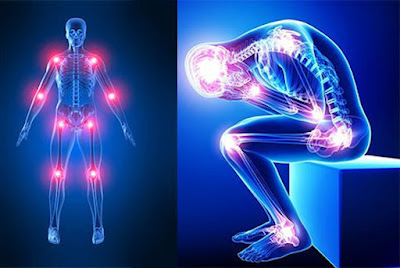Fibromyalgia
WHAT IS IT?
Fibromyalgia is a disorder characterized by widespread musculoskeletal pain that’s often accompanied by other symptoms, including fatigue or sleep difficulties.
Researchers believe that among people with fibromyalgia the way that the brain processes pain signals is amplified. In addition, the brain’s pain receptors become more sensitive than normal, causing them to overreact to pain signals.
Because fibromyalgia tends to run in families, there may be certain genetic mutations that may make individuals more susceptible to the disorder. Symptoms may begin after a physical trauma, surgery, infection or significant psychological stress. Women are much more likely to develop fibromyalgia than are men.
SYMPTOM CHECKER Symptoms of fibromyalgia include:
• Widespread pain.
The pain associated with fibromyalgia often is described as a constant dull ache that has lasted for at least three months. To be considered widespread, the pain must occur on both sides of your body and above and below your waist.
• Fatigue.
People with fibromyalgia often awaken tired, even though they report sleeping for long periods. Some people have sleep disorders such as restless legs syndrome and sleep apnea.
• Cognitive difficulties.
A symptom commonly referred to as “fibro fog” impairs the ability to focus, pay attention and concentrate on mental tasks.
• Other problems.
Some people experience depression, headaches, and pain or cramping in the lower abdomen.
TREATMENT
Because many of the signs and symptoms of fibromyalgia are similar to other disorders, it may take a while to receive a diagnosis.
In the past, doctors would check 18 specific points on a person’s body to see how many of them were painful when firmly pressed. Newer guidelines don’t require a tender point exam. Instead, a diagnosis can be made if a person has had widespread pain for more than three months — with no underlying medical condition that could cause the pain.
Treatments for fibromyalgia include both medication and therapy, with an emphasis on minimizing symptoms.
Medications
Medications are used to reduce pain and improve sleep.
Pain relievers.
Over-the-counter pain relievers may help.
Your doctor might suggest a prescription pain reliever such as tramadol (Ultram, Conzip) if over-the-counter products don’t work.
Narcotics aren’t advised.
They can lead to dependence and worsen the pain.
Antidepressants.
Duloxetine (Cymbalta) and milnacipran (Savella) may be prescribed to treat pain and fatigue. Amitriptyline or fluoxetine (Prozac) are sometimes prescribed to help promote sleep.
Anti-seizure drugs.
Medications to treat epilepsy may reduce certain fibromyalgia pain. The drug gabapentin (Neurontin, Gralise) may relieve symptoms. Pregabalin (Lyrica) was the first drug approved by the Food and Drug Administration to treat fibromyalgia.
Cognitive behavioral therapy
Some people find talking with a counselor and learning strategies for dealing with fibromyalgia to be helpful in reducing symptoms.
LIFESTYLE To help manage fibromyalgia symptoms:
• Reduce stress.
Try to avoid or limit overexertion and emotional stress. Allow yourself time each day to relax, but remain active.
• Get enough sleep.
Adequate sleep is essential. Practice good habits, such following a sleep schedule and limiting napping.
• Exercise regularly.
At first, exercise may increase your pain. But doing it regularly often decreases symptoms.
• Pace yourself.
Moderation means not overdoing it on your good days, and not doing too little on the days when symptoms flare.
• Maintain a healthy lifestyle.
Eat a balanced diet and maintain a healthy weight. Limit your caffeine intake. Every day, do something that you find enjoyable and fulfilling.


تعليقات
إرسال تعليق